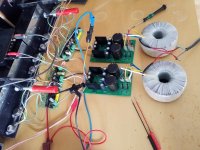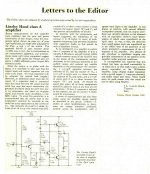The case is surprisingly bulky (200W x120H x 210Deep) and the ribbed heatinks are about 200W x 120H x 35D, aided by the other aluminium panels, meaning it should cope with 10W in class A as it has as much heatsink volume as other finished JLH'69 products rated 10-15W. If you live in a warm climate or just prefer to have your amp. run cooler, it should not be too hard to strip the heatsinks from the case and their adaptor bracket (which seems to be how the semis are attached). Then you could clean and black anodize the 'sinks, making what could be the best single improvement of the existing design.
Hello all,
One tends not to look at JLH's original article and see this;

I've fiddled with it in photoshop to make it a bit easier to see, those heatsinks are 4" wide and 5" deep, two 2N3055's on each side
Apparently no need for the genus Heatsinkium Giganticus
Cheers
One tends not to look at JLH's original article and see this;
I've fiddled with it in photoshop to make it a bit easier to see, those heatsinks are 4" wide and 5" deep, two 2N3055's on each side
Apparently no need for the genus Heatsinkium Giganticus
Cheers
It's a matter of inexperience. Few people building the JLH 10-15 watter for the first time, will have much experience with fully class A amplifiers and will probably expect only the lukewarm temperatures of class AB or D, as applied to home stereo, home theatre or personal sound systems, which normally run only warm at domestic sound levels.
With correct bias, those slender sinks pictured inside the casing shown in the original article, will actually become too hot to keep your finger on them since they are only lightly coupled to the outer cover but there should soon be a good convectional draught flowing up that 5" chimney which does most of the cooling.
With correct bias, those slender sinks pictured inside the casing shown in the original article, will actually become too hot to keep your finger on them since they are only lightly coupled to the outer cover but there should soon be a good convectional draught flowing up that 5" chimney which does most of the cooling.
Last edited:
Hello Ian,
I didn't realise what JLH's tin box was actually for, thanks for that. Thinking about it it's a very good idea and after all it's CLASS A and it doesn't matter what it looks like, after all it's streets ahead of anything else.
I've put up a little blog/site and put on this page what you said, https://jlh1969classa.blogspot.com/p/my-build.html if you'd prefer I can remove your name, the site has got the stop robots indexing txt at the moment so no one else can see it yet.
Cheers
I didn't realise what JLH's tin box was actually for, thanks for that. Thinking about it it's a very good idea and after all it's CLASS A and it doesn't matter what it looks like, after all it's streets ahead of anything else.
I've put up a little blog/site and put on this page what you said, https://jlh1969classa.blogspot.com/p/my-build.html if you'd prefer I can remove your name, the site has got the stop robots indexing txt at the moment so no one else can see it yet.
Cheers
Hello all,
My switched test from my listening position this was in mono one side of the JLH and one side of my 3886; to begin with, immediately, I thought the rise in the JLH volume a bit faster and louder was my wishful thinking.
I then began to notice that instruments were more defined they seemed to have more 'about' them with the JLH especially pianos and and acoustic guitars. The Eurorack modular synth no keyboard work of Hélène Vogelsinger was also a lot clearer.
I've done these tests in the past for a week to make sure the one I thought better, actually was. Not so with the JLH four days was enough to convince me that it is certainly not wishful thinking on my part
This Class A caper is something else entirely, Nigel Pearson said; bright, fast, detailed & analytical I would add to that 'transparent'.
It is astonishing I laughed and thought this has got to be the electronical 'joke' of the last 50+ years. How can so much come from something so small?
Cheers and thanks a million for your help - J
Almost finished

https://jlh1969classa.blogspot.com/
My switched test from my listening position this was in mono one side of the JLH and one side of my 3886; to begin with, immediately, I thought the rise in the JLH volume a bit faster and louder was my wishful thinking.
I then began to notice that instruments were more defined they seemed to have more 'about' them with the JLH especially pianos and and acoustic guitars. The Eurorack modular synth no keyboard work of Hélène Vogelsinger was also a lot clearer.
I've done these tests in the past for a week to make sure the one I thought better, actually was. Not so with the JLH four days was enough to convince me that it is certainly not wishful thinking on my part
This Class A caper is something else entirely, Nigel Pearson said; bright, fast, detailed & analytical I would add to that 'transparent'.
It is astonishing I laughed and thought this has got to be the electronical 'joke' of the last 50+ years. How can so much come from something so small?
Cheers and thanks a million for your help - J
Almost finished
https://jlh1969classa.blogspot.com/
Hello CC,
Thanks for the question;
It's a 10 Watt one; here a link to AliExpress
I bought the kit years ago and thought it useless there are no adjustments on it.
Then a few weeks ago I came across Steve Wagner whose done an instrument test on it it's on YouTube.
I put 12 Volts into it and get about 5 Watts out into my MA CHP-70's in FH3's.
They are 85 db so a nasty transient might get up to 1 Watt 🙂
Cheers
Thanks for the question;
It's a 10 Watt one; here a link to AliExpress
I bought the kit years ago and thought it useless there are no adjustments on it.
Then a few weeks ago I came across Steve Wagner whose done an instrument test on it it's on YouTube.
I put 12 Volts into it and get about 5 Watts out into my MA CHP-70's in FH3's.
They are 85 db so a nasty transient might get up to 1 Watt 🙂
Cheers
It is amazing little amp, so what's up next? The dual rail jlh, has a bit more horse power..
Hello AD,
I've no reason to change nice of you to make the suggestion though.
I'm a listener rather than a builder 🙂
Cheers
Okay, I'm the opposite I guess.
How is hum on your amp? Is it audible?
I see some room for minor improvements, especially on psu part.
How is hum on your amp? Is it audible?
I see some room for minor improvements, especially on psu part.
Hello AD,
Yes the hum was a problem but the kind folks on here helped with it.
So I used screened cable for the input, and twisted cables for everything else.
If I stick my ear'ole right up against a speaker I can hear some hum, but quieter than my 3886.
May ask if the minor improvements can be soldered to my existing configuration?
Cheers
Yes the hum was a problem but the kind folks on here helped with it.
So I used screened cable for the input, and twisted cables for everything else.
If I stick my ear'ole right up against a speaker I can hear some hum, but quieter than my 3886.
May ask if the minor improvements can be soldered to my existing configuration?
Cheers
@ #8795
Nice work!
Do not use wood or wood-based materials for casing. Sounds flat, noisy, gray, cloudy.
Do use one input ground (cinch socket) only (ground loop).
The four powercaps set on one circuit (head scratching work;-)
I would not use little bridging caps: sound like distorting mirror at the carnival; moreover oscillating circuits.
I would not use the solder lugs of cinch sockets and speaker terminals. Solder direct.
Have much fun!
Nice work!
Do not use wood or wood-based materials for casing. Sounds flat, noisy, gray, cloudy.
Do use one input ground (cinch socket) only (ground loop).
The four powercaps set on one circuit (head scratching work;-)
I would not use little bridging caps: sound like distorting mirror at the carnival; moreover oscillating circuits.
I would not use the solder lugs of cinch sockets and speaker terminals. Solder direct.
Have much fun!
What cumbb said.. and yes those mods can easily be applied.
Man I hate those cheap screw terminals..🤢
Man I hate those cheap screw terminals..🤢
Hello all,
I've copied and pasted all your comments into a txt file and I will endeavour to make use of all of them.
Thanks to you all for your patient explanations I am grateful.
Cheers
And despite the timber it's the best amp I've ever made 🙂
I've copied and pasted all your comments into a txt file and I will endeavour to make use of all of them.
Thanks to you all for your patient explanations I am grateful.
Cheers
And despite the timber it's the best amp I've ever made 🙂
That's called RFI. It's not the fault of the wood. Plastic cases have the same problem, as one of my employers found out a long time ago.Do not use wood or wood-based materials for casing. Sounds flat, noisy, gray, cloudy.
You all could, for example, place the amplifier on small pieces of different materials: Wood, plastic, stone, rubber, steel, aluminum. And it will sound different every time.
The shape of the pieces not yet included;-)
The shape of the pieces not yet included;-)
- Home
- Amplifiers
- Solid State
- JLH 10 Watt class A amplifier

